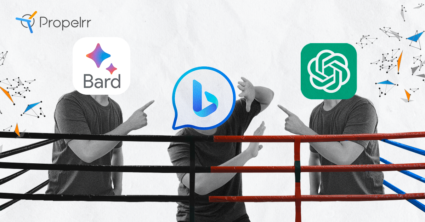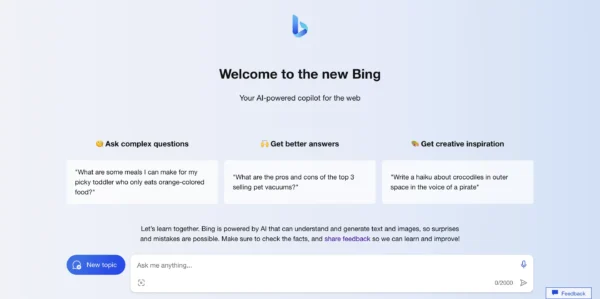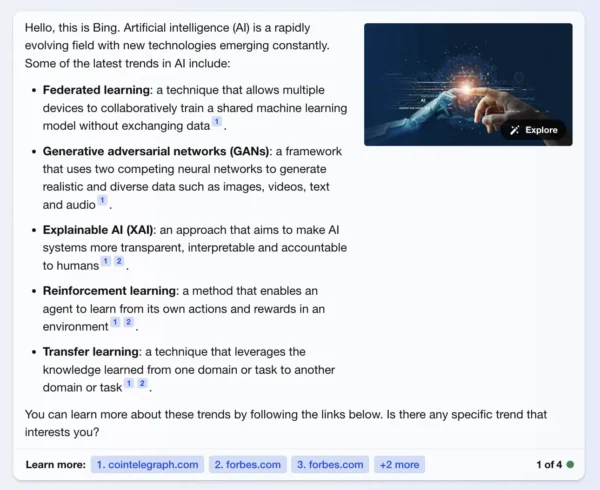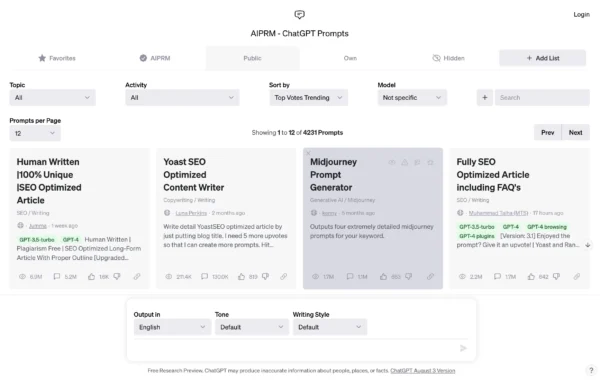AI Pros and Cons: Google Bard vs Bing Chatbot vs ChatGPT
Author & Editor
Content Specialist
Published on: Sep 8, 2023 Updated on: May 16, 2024

The evolution of search engines has been nothing short of innovative in recent years.
Thanks to the power of artificial intelligence, the way we search for information online has undergone a transformation. Leading the way in this new era of search are Google Bard, Bing Chatbot, and ChatGPT – three platforms that are setting the standard for the future of search.
Google Bard, created as an immediate reaction to the popularity of OpenAI's ChatGPT, was developed by Google's AI team in 2021. This experimental project pushes the boundaries of what we thought was possible in the realm of natural language processing.
Coinciding with the release of Bard, Microsoft launched a new AI-enhanced Bing Chatbot, a conversational AI agent that can provide customer support and assistance to users through a chat interface. It uses natural language processing (NLP) and machine learning algorithms to understand and respond to user queries and requests.
Using advanced deep-learning technology, this AI-enabled search platform maps user speech patterns to stored responses, creating a seamless and intuitive search experience.
And then there's ChatGPT, a next-generation language model-based AI chatbot engine that is powered by GPT-3.5 architecture to provide accurate and precise responses to user inquiries with a vast database at its disposal. It can engage in natural language conversations with users and perform a wide range of tasks, such as answering questions, generating text, summarizing information, and more.
The world of search is no longer ruled by simple algorithms and keyword matching. Artificial Intelligence or AI has taken over as the trusted advisor for search engines. With AI at its side, search engines can understand the real intention behind a user's query through natural language processing or NLP, delivering personalized results that cater to their specific interests and needs. But it does more than just fine-tune search results.
They also track user behavior to refine algorithms that make sure you get the right answer when you scroll for it. Through this process, search engines become smarter as they identify user trends and preferences.
Although there is some controversy surrounding AI searches, the data privacy issues are a bit concerning and the algorithms aren't particularly transparent, so you should be wary when trusting the quality of their results. But by incorporating AI into search, we get an extra layer of personalization that combines each user's unique search history, location data, and other variables to create a customized search experience.
The AI Showdown: Google Bard vs Bing Chatbot vs ChatGPT
As AI technology continues to advance, it's important to weigh the benefits and risks of using these AI-powered search engines and to be mindful of how our personal data is being used.
Google Bard
Google has created a revolutionary AI chatbot, Bard. It is capable of carrying on intricate conversations with users and accessing an online database of information from the internet to back up its answers.
1/ In 2021, we shared next-gen language + conversation capabilities powered by our Language Model for Dialogue Applications (LaMDA). Coming soon: Bard, a new experimental conversational #GoogleAI service powered by LaMDA. https://t.co/cYo6iYdmQ1
— Sundar Pichai (@sundarpichai) February 6, 2023
Unfortunately, the launch was not quite a blastoff as Bard delivered inaccurate information about the James Webb Space Telescope (JWST) in the first demo posted on Twitter. In response to the prompt: "What new discoveries from the James Webb Space Telescope can I tell my 9-year-old about?" Bard answered with: "JWST took the very first pictures of a planet outside of our own solar system."
This turned out to be incorrect as the first photo of an exoplanet was taken by European Southern Observatory’s VLT back in 2004.
Bard is an experimental conversational AI service, powered by LaMDA. Built using our large language models and drawing on information from the web, it’s a launchpad for curiosity and can help simplify complex topics → https://t.co/fSp531xKy3 pic.twitter.com/JecHXVmt8l
— Google (@Google) February 6, 2023
Despite the rocky start, Google rolled out Bard to a small group of “trusted testers” and initiated the waitlist in March of 2023. They then announced that they were still putting their AI chatbot through its paces.
Unlike ChatGPT, Bard uses Language Model for Dialogue Applications technology or LaMDA, as well as Google's Transformer neural network architecture which also powers GPT-3.5: the language model behind ChatGPT.
Currently, the availability of the tool is limited to the US and UK, and it has not yet expanded to other regions or countries. Hopefully, you will be able to try it out soon.
Unique features of Google BARD:
- It has access to a search engine and can respond to modern queries. Bard has the ability to utilize Google's search engine, whereas ChatGPT is limited to the information it was trained on until 2021 and does not have access to the internet.
- It is powered by LaMDA. As aforementioned, Bard makes use of its own large language model called LaMDA. It was specifically designed for generating responses in conversational contexts, such as chatbots or virtual assistants.
- It can handle complex data processing. It can condense complicated topics into easily understandable and conversational fragments. This approach aims to enhance the accessibility of knowledge and facilitate learning for a wider audience, including children.
- It has a Drafts feature. In case you are dissatisfied with Bard's initial reply or if you require additional information, you can utilize Bard's Drafts functionality, which enables you to examine several iterations of its responses.
What is Google Bard ideally used for?
- Content Generation. Using Bard for automated content creation can vastly reduce the effort, cost, and time associated with creating content. This technology is suitable for websites and social media accounts, producing relevant and engaging output that speaks to its target audience. With the capacity to create vast amounts of content at scale, Bard offers a cost-effective approach to achieving your content creation goals.
- Formulating summaries of written materials. You can use Bard to break down the articles, webpages, or even research papers into constituent parts, analyzing each part, and synthesizing the information into a coherent summary.
- Craft poems and other creative writing forms. Bard can help authors rustle up all sorts of ideas, providing prompts, inspiration, and even the ability to complete certain aspects of the writing process. Additionally, it serves as a meticulous editor and proofreader, deftly identifying potential errors in grammar, punctuation, and spelling, and providing suggestions for improvement. It can help writers construct coherent and compelling works by identifying plot holes, smoothing out inconsistencies, and adding intricate details where needed.
Pros of Google BARD
- It has the capacity to produce grammatically accurate and contextually fitting text, making it a valuable asset if you are seeking to incorporate virtual assistants.
- It is tailored to provide current and relevant responses, operating on the Google search engine.
- It collects user feedback to enhance the performance and effectiveness of the AI system in the future.
- Its Drafts feature lets you save their ongoing research and writing in one place, making it easier to identify and incorporate relevant information into their work.
Cons of using Google BARD
- When compared to advanced language models such as ChatGPT, its functionality is restricted, and at times it may provide inaccurate information or neglect crucial details.
- Due to the data it learns from, it may unintentionally replicate real-world prejudices and stereotypes. Consequently, it could produce responses that are unsuitable or offensive, potentially harming specific individuals or groups.
- It gathers and retains confidential user information, which may lead to apprehensions about the safety and privacy of data.
- It omits citations for its sources and you may face obstacles when attempting to authenticate the accuracy and trustworthiness of the provided information. Bard, however, will acknowledge and hyperlink sources if it "directly quotes at length from a webpage."
Bing Chatbot

In February 2023, Microsoft debuted the latest version of Bing, complete with a noteworthy integration: ChatGPT. Among the highlights of this impressive release is a chat feature that boasts a next-gen version of OpenAI's famed language model which, Microsoft claims, surpasses even ChatGPT in its power and precision.
The AI-powered Bing Chatbot delivers responses that are almost indistinguishable from human interaction, with supporting footnotes to bolster its credibility. Moreover, the chatbot's range extends beyond simple fact-finding to encompass creative assistance, such as writing poems, stories, and songs.
The brains behind Bing Chatbot is the GPT-4 technology developed by OpenAI, which uses generative AI models to process data into natural-language responses. iOS and Android users can readily access this groundbreaking chatbot via Bing, Edge, and Skype apps.
Unlike Bard, Microsoft has put an end to the waitlist for its AI-powered Bing Chat feature, offering unrestricted access to the GPT-4 enabled chatbot that is now available upon logging into the Bing platform.
Unique features of Bing Chatbot
- It has three distinct personality styles. Bing Chatbot boasts a trio of personalities that you can converse with: creative, balanced, and precise.
The creative persona is characterized by playful and imaginative responses, whereas the balanced persona strives to offer neutral and objective feedback. And for utmost accuracy, the precise persona prioritizes providing you with accurate and detailed information. - It can convert data into various formats. One of Bing's key features lies in its ability to comb the web for up-to-date information, which it can then convert into various formats.
- It cites its sources. Unlike Bard, Bing's thoroughness extends to citing all of its sources, enabling you to view the links to the web content that it references. This feature bolsters transparency and allows you to verify the reliability of the information presented to you.For example, I typed in a question to Bing regarding the famous tales featured in The Canterbury Tales, and the outcome is as follows:

You now have a quick and easy way to verify search results through Bing's ability to input the sources from which it gathered the needed data. - It can assist with business operations. It allows you to create customized chatbots designed to meet your unique requirements. By leveraging the platform's advanced natural language processing capabilities, you can develop automated conversations with your customers that provide them with the information they need quickly and efficiently.
What is Bing Chatbot ideally used for?
- Data visualization. It can break down information into concept maps and tables, making it easy to understand and analyze complex data sets.
- Product recommendation. It can also assist in comparing specifications and features of various products across different vendors, helping you to find the best deals. By doing this, the chatbot provides you with a comprehensive overview of your shopping options, highlighting the pros and cons of each product, and allowing you to make a more informed decision.
- Conversational interface for businesses. It enables you to build chatbots that can perform a wide range of functions, including answering customer queries, providing customer service, and guiding customers through the sales process. By automating these functions, you can reduce wait times, improve customer satisfaction, and increase overall efficiency.
Pros of using Bing Chatbot
- Its three distinct personalities–creative, balanced, and precise–offer you a means of compartmentalizing the nature of the ideas you encounter during your searches. This means that Bing equips you with a versatile and adaptable approach to interpreting search results, enabling you to extract the most relevant and useful information with ease.
- Its provision of links to the web content it references makes it easy for you to directly investigate and access the sources cited. This expedites the research process, letting you to source and authenticate information much more quickly.
- It has the ability to transform data into various forms, like side-by-side charts. These charts can be useful in breaking down information, making it easy to compare and contrast options. For instance, when you're undecided between two items to buy, Bing can provide you with comparative charts to aid in decision-making.
Cons of using Bing Chatbot
- There's a cap on the number of chats you can have in one session and in a day to keep the system from getting too swamped. Microsoft has only recently raised the cap to 15 chats per session and 150 chats per day.
- Despite having a "creative" feature, ChatGPT still surpasses it in terms of comprehensiveness. This means that it still falls short compared to ChatGPT's ability to understand and generate content in detail.
Although ChatGPT and Bing Chat employ the same underlying technology, they still offer distinct user experiences and provide varying responses to numerous inquiries, despite sharing similar theoretical foundations.
ChatGPT

It was June 2020 when the world saw the introduction of ChatGPT’s latest version – GPT-3. With an unprecedented 175 billion parameters, it is by far the largest language model to ever be created.
ChatGPT is a revolutionary language model that employs GPT (Generative Pre-trained Transformer) architecture, which is a deep learning model that uses self-attention mechanisms to generate coherent and natural language text, utilizing a deep learning approach to natural language processing. In its pre-training phase, ChatGPT is fed an enormous corpus of text data from various sources, including websites, books, and more, all through the power of unsupervised learning.
As the model digests this vast trove of linguistic information, it gradually develops an intimate understanding of the intricate patterns and underlying structure of language, including grammar, syntax, and semantics. This foundation of knowledge serves as the bedrock for ChatGPT's ability to generate responses that are both coherent and contextually appropriate, capable of handling a wide range of queries and prompts.
So when you input a query or prompt, ChatGPT springs into action, using its worldly analysis to generate a response that accurately reflects the nuances of the input.
ChatGPT is still the most sophisticated language model on the market, capable of doing things like translating dialogues to different languages, responding to complex inquiries, and compactly summarizing long articles.
At present, ChatGPT boasts two formidable GPT models that cater to a variety of users. The default model, GPT-3.5, may be less powerful than its counterpart, but it remains free for all to use. On the other hand, the advanced GPT-4 model is only accessible to ChatGPT Plus subscribers.
Unique features of ChatGPT
- It has contextual understanding. It has the ability to understand the context and respond appropriately based on the conversation's previous messages. It uses a technique called attention mechanisms to pay attention to important words and phrases in a sentence.
- It is adaptable. It can be fine-tuned to a specific task or domain, allowing it to specialize in a particular field, such as medical diagnosis, legal advice, or customer support.
- It has the most natural language generation compared to Bard and Bing. It can generate text that is almost always grammatically correct, semantically coherent, and contextually appropriate. This makes it useful for a wide range of tasks, including chatbots, text summarization, and content creation.
What is ChatGPT ideally used for?
- Content creation. It can be used to develop text content for a variety of creative applications, including songs, poems, and or even recipes.
- Language translation. It can be used to translate text from one language to another, which can be useful for businesses and organizations that operate globally.
- Student assistance. It can be used in education to answer student questions, provide feedback, and outline written materials for essays, academic papers, etc.
- Data analysis. It can be used to analyze interactions and provide insights into customer behavior, preferences, and needs.
- Marketing projects. It can be used to develop text content for marketing campaigns, such as social media posts, email newsletters, content creation ideas, and website copy.
Pros of using ChatGPT
- It can process large amounts of text data quickly and efficiently, which allows it to respond to queries in real time.
- It has been trained on a vast corpus of texts, which means that it has a significant amount of knowledge on various topics.
- It can learn from previous interactions and personalize responses based on individual users' preferences and behaviors.
- It can be used in a variety of applications, including customer service, language translation, content creation, and more.
Cons of using ChatGPT
- It does not have the same level of contextual understanding as a human, which means that it may sometimes provide lacking or irrelevant responses.
- Its responses depend heavily on the quality of the training data it has been exposed to, and it only has access to information until 2021. If the data is biased or incomplete, ChatGPT may provide skewed or incomplete responses.
- Since it processes and stores data, there may be concerns about privacy and security, particularly in cases where sensitive information is involved.
AI chatbots have become a part of our daily lives, assisting us in everything we do – from making reservations and booking flights to even providing emotional support. Businesses are also taking advantage of the efficiency and scalability that comes with these automated helpers.
However, while AI chatbots do have their upside, let's not forget that they cannot take the place of human-to-human interaction. We must remember that they lack the highly-specialized emotional intelligence and originality that humans possess. Plus, there are probably certain complex scenarios that require empathy and human judgment that just aren't in AI’s capabilities.
Whereas chatbots rely on rigid, pre-programmed algorithms and data inputs to formulate responses, humans possess the ability to push boundaries and devise solutions that chatbots never could. We don't just stick to the script, we think outside the box and use our creativity and problem-solving skills in unique ways to come up with innovative solutions.
Key takeaways
AI technology presents a lot of opportunities to scaling digital marketing both for big corporations and small businesses. But for all the benefits that they provide, there is still much left to figure out in terms of regulation and using them ethically.
When integrating them into your business, make sure to note that:
- Google Bard, Bing Chatbot, and ChatGPT are all AI-based search tools designed to help you find information quickly and easily. While each platform has its own unique features and benefits, ChatGPT currently stands out as the most advanced and versatile of the three.
- AI can be useful in analyzing large volumes of content to identify common themes, topics, and keywords, which can then be used to create a high-level outline or summary of the material. This can save you time and effort while still ensuring consistency and coherence across different pieces of content.
- Despite their many benefits, AI-powered search tools also have some drawbacks, including the potential for bias, lack of transparency, and reliance on pre-existing data sets. As such, it is important for you to be aware of these limitations and use these tools in conjunction with other sources of information to ensure a comprehensive and accurate understanding of the topic at hand.
Feel free to share your feedback and insights with us by following our social media accounts and leaving us a message on Facebook, LinkedIn, and X.
Make sure to subscribe to our newsletter and stay updated on the latest digital marketing trends and tips.
